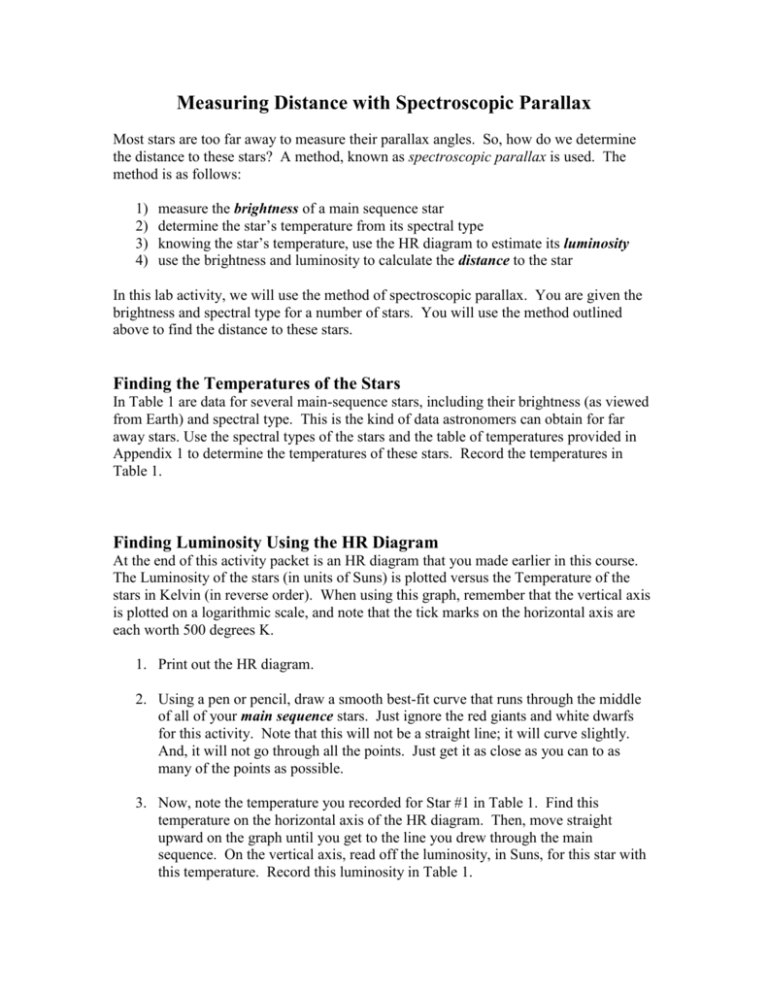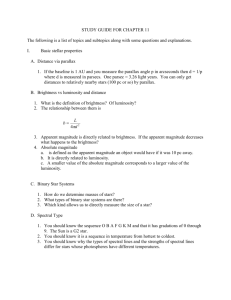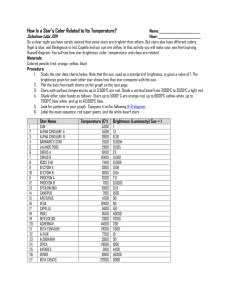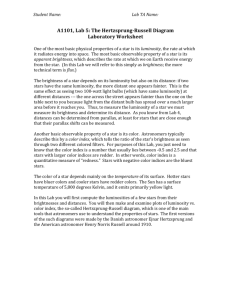to the Word version of the instructions.
advertisement

Measuring Distance with Spectroscopic Parallax Most stars are too far away to measure their parallax angles. So, how do we determine the distance to these stars? A method, known as spectroscopic parallax is used. The method is as follows: 1) 2) 3) 4) measure the brightness of a main sequence star determine the star’s temperature from its spectral type knowing the star’s temperature, use the HR diagram to estimate its luminosity use the brightness and luminosity to calculate the distance to the star In this lab activity, we will use the method of spectroscopic parallax. You are given the brightness and spectral type for a number of stars. You will use the method outlined above to find the distance to these stars. Finding the Temperatures of the Stars In Table 1 are data for several main-sequence stars, including their brightness (as viewed from Earth) and spectral type. This is the kind of data astronomers can obtain for far away stars. Use the spectral types of the stars and the table of temperatures provided in Appendix 1 to determine the temperatures of these stars. Record the temperatures in Table 1. Finding Luminosity Using the HR Diagram At the end of this activity packet is an HR diagram that you made earlier in this course. The Luminosity of the stars (in units of Suns) is plotted versus the Temperature of the stars in Kelvin (in reverse order). When using this graph, remember that the vertical axis is plotted on a logarithmic scale, and note that the tick marks on the horizontal axis are each worth 500 degrees K. 1. Print out the HR diagram. 2. Using a pen or pencil, draw a smooth best-fit curve that runs through the middle of all of your main sequence stars. Just ignore the red giants and white dwarfs for this activity. Note that this will not be a straight line; it will curve slightly. And, it will not go through all the points. Just get it as close as you can to as many of the points as possible. 3. Now, note the temperature you recorded for Star #1 in Table 1. Find this temperature on the horizontal axis of the HR diagram. Then, move straight upward on the graph until you get to the line you drew through the main sequence. On the vertical axis, read off the luminosity, in Suns, for this star with this temperature. Record this luminosity in Table 1. 4. We will now convert the luminosity in Suns to units of Watts. To do this, just multiply the number in Suns by the luminosity of the Sun, which is 3.846 x 1026 Watts, and record this in the next column of Table 1. 5. Repeat these steps for the rest of the stars, so that you have all of their luminosities in Watts. Finding the Distances to the Stars Using the data you have so far, you can determine the distance to each of your stars. Recall that there is a relationship between brightness, luminosity, and distance. B L 4 d 2 This can be rearranged such that, if you know the brightness and luminosity, you can calculate the distance, L , d 4 B Where L is in Watts, B is in Watts per square meter, and d comes out in meters. 1. Using the given brightness (in Watts per square meter) and the luminosities you found (in Watts), calculate the distance to each star and record the distances (in meters) in Table 1. 2. There are 9.46×1015 meters in one light-year. Convert your distances to lightyears by dividing the distance in meters by this number. 3. Recall that our Milky Way galaxy is 100,000 light-years across. For each of your stars, use the space below to explain whether it is most likely inside our galaxy or outside our galaxy. Table 1 – Star Properties Star Spectral Type Temperature (K) Brightness (Watts/m2) #1 B2 4.00×10−10 #2 A0 3.42×10−10 #3 G0 1.37×10−10 #4 B5 1.90×10−15 Luminosity (Suns) Luminosity (Watts) Distance (meters) Distance (lightyears) Table 2 – Approximate Temperatures of Main-Sequence Stars Spectral Type O5 O6 O7 O8 O9 B0 B1 B2 B3 B5 B6 B7 B8 B9 A0 A1 A2 A3 A4 A5 A7 F0 F2 F3 F5 F6 F7 F8 Temperature (K) 54,000 45,000 43,300 40,600 37,800 29,200 23,000 21,000 17,600 15,200 14,300 13,500 12,300 11,400 9600 9330 9040 8750 8480 8310 7920 7350 7050 6850 6700 6550 6400 6300 Spectral Type G0 G1 G2 G5 G8 K0 K1 K2 K3 K4 K5 K7 M0 M1 M2 M3 M4 M5 M6 M7 M8 Temperature (K) 6050 5930 5800 5660 5440 5240 5110 4960 4800 4600 4400 4000 3750 3700 3600 3500 3400 3200 3100 2900 2700 100000 10000 1000 10 1 0.1 0.01 0.001 0.0001 0.00001 25000 20000 15000 10000 Surface Temperature (K) 5000 0 Luminosity (Suns) 100









